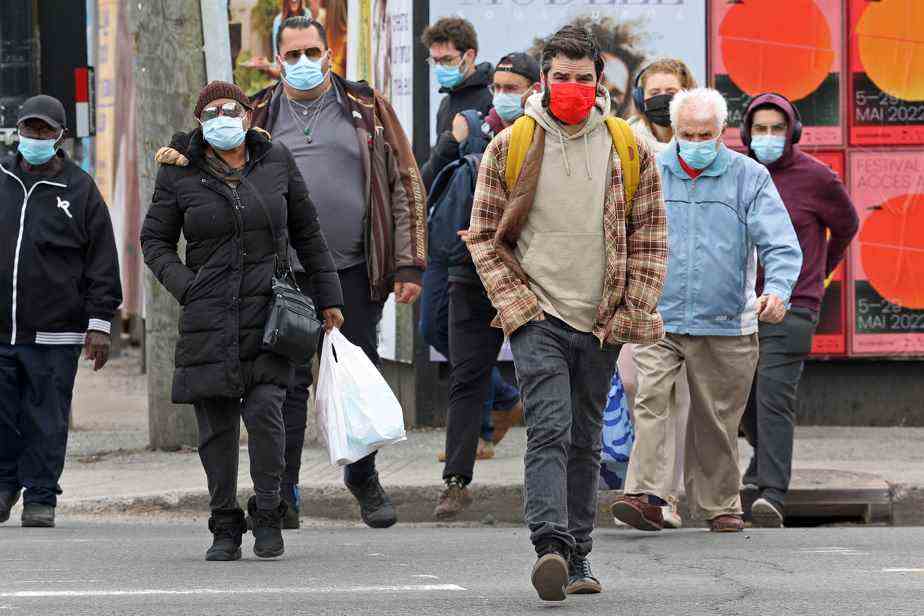(Montreal) As we began the year 2022, the theme on everyone’s lips was that of “learning to live with the virus” of COVID-19. Twelve months later, we see that cohabitation with a potentially deadly virus is proving to be rather stormy and that the consequences can be serious.
After two years of fierce fight against successive waves of infections with strong blows of restrictive measures of all kinds, political leaders pleaded for the adoption of a “new normal” by adapting our behavior to the presence of the SARS CoV virus. -2.
Thus, despite the meteoric spread of the Omicron variant and the sub-variants that followed, public health announced relaxations in its constraints from the end of January. The end of the obligation to wear a mask in public places will then come in the spring.
In response, several experts have regularly called for caution, fearing that the population will interpret this “new normal” as a pure and simple return to life before. In fact, wearing a mask has been largely neglected and the triple epidemic of the fall (COVID-19, influenza, respiratory syncytial virus) suggests that many people continue to adopt risky behaviors when they present with flu symptoms.
Data compiled by the National Institute of Public Health of Quebec (INSPQ) confirms that “cohabitation with the virus” leads to greater exposure to risk and many more infections. As of December 18, there were 633,802 confirmed infections in 2022, almost the equivalent of the first two years of the pandemic combined (641,777 cases). A number all the more spectacular as access to screening tests has been restricted since the beginning of the year.
Consistently, the number of hospitalizations related to COVID-19 has also jumped. As of December 18, it stood at 49,590 new admissions, more than in the first two years of the health crisis (30,043 admissions).
Then, as the number of hospitalized patients increases, so does the number of deaths. As of December 18, 5,688 Quebecers have succumbed to COVID-19 in 2022, which represents an increase compared to 2021.
Forgotten Lessons
In the eyes of the professor of social and preventive medicine at the School of Public Health at the University of Montreal, Benoît Mâsse, there are clearly “things that we have not learned”. He is concerned about the authorities’ reaction time to the rise in influenza cases this fall, when we should have developed better reflexes after two years of the pandemic.
“If there’s one thing we should have learned, it’s that we shouldn’t wait until the emergency room is full to act,” he laments.

PHOTO MARCO CAMPANOZZI, PRESS ARCHIVES
Benoît Mâsse, professor of social and preventive medicine at the School of Public Health of the University of Montreal
On an individual level, Quebecers must also adapt their behavior for cohabitation to work.
“Each of us is responsible for reducing community transmission, insists the virologist. If you have symptoms, you must stay at home, if you have the slightest doubt that you are contagious, you must isolate yourself. »
Wearing a mask must also be part of the equation and become a commonplace gesture in public places when you display symptoms or have doubts.
“These are not reflexes that we had before, but that’s living with the virus,” he insists, conceding that changes in societal behavior take time. Over the generations, we have seen campaigns against smoking, against drunk driving or in favor of wearing seat belts. Each time, progress has been observed over long periods of time.
Living with the consequences
The adaptation of daily life is not the only drawback of the “new normal”, as Benoît Mâsse points out: “Living with the virus is also living with the consequences. And one of the serious consequences takes the form of an epidemic of chronic disease inside the viral pandemic.
More and more health experts as well as political leaders are concerned about the chronic form of COVID-19 commonly referred to as long COVID.
On the occasion of the publication of a preview of the forthcoming report of the Task Force on the post-COVID-19 condition, on December 14, the Chief Science Advisor of Canada revealed that it is 1.4 million Canadians who have reported COVID symptoms long so far.
The DD Mona Nemer confirmed that more and more people report suffering from muscle aches, shortness of breath, extreme fatigue, mental fog, gastrointestinal disturbances or heart palpitations, among other things, more than a month after contracting an infection. to the SARS CoV-2 virus.
If we still do not know the mechanisms that lead to the development of the chronic form, we know that women are twice as at risk than men and that this condition disrupts the lives of patients.
“People have said they feel trapped in their bodies, isolated and misunderstood by those around them. Many had difficulty obtaining care or services. The majority have lost their jobs due to this disability,” reported the DD Nemer at a press conference.
Citing US estimates, she mentioned that ten million people with long-term COVID would cost society about US$3.7 trillion in lost quality of life, lost income and burden on the healthcare system.
In a recent study published in the Journal of the Association for Medical Microbiology and Infectious Disease Canadathe Dr Alain Piché and his colleagues from the University of Sherbrooke demonstrated a high prevalence of long-lasting COVID in people infected with subvariants of the Omicron lineage.
These researchers observed that 47.2% of participants in their study were still experiencing symptoms more than a month after testing positive for COVID-19. This is alarming data as the BQ.1 and BQ.1.1 sub-variants have taken over as the most virulent strain. Two newcomers from the great Omicron family.
The year 2023 could therefore look like a variation on the same theme, while we will have to learn to live with the long COVID.
The Canadian Press health content gets funding through a partnership with the Canadian Medical Association. The Canadian Press is solely responsible for editorial choices.
